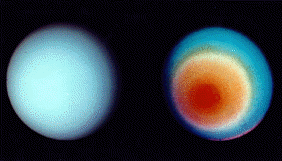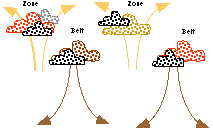This is an image of Uranus.
Click on image for full size
NASA
An Overview of Uranus' Atmosphere
The plain bluegreen face of Uranus shows that Uranus is made of of only one thing. Beside clouds, there is also smog.
Uranus' atmosphere is still forming.
Motions in the cloud patterns indicate that, like Jupiter and Saturn, the winds of Uranus move in a striped pattern. This means that, even though the pattern is hard to see, Uranus is striped, just like Jupiter and Saturn.
Uranus is the most strange planet of all because the daytime on Uranus lasts for the whole
summer. In fact, Uranus has very strange seasons because it is a sideways planet!
You might also be interested in:

The clouds of Uranus, made of methane crystals, are found very low in the sky, and are difficult to find beneath the hazey smog of the pla net. False color is used, in the picture of Uranus to the right,
...more
In this picture, the Earth and Uranus are both viewed from the top. In the picture of the Earth, the sun is shining from the side. The picture shows that part of the north pole is in daylight and part
...more
Besides methane, Uranus' atmosphere contains even more complex molecules. These molecules form layers of smog over the clouds of Uranus, as shown in the picture.
...more
On Uranus, as on Jupiter, the winds in the belts and zones blow first in one direction, then in the other direction. The clouds rise up in a belt, and drop down in a zone, as shown in this picture. This
...more
The clouds on Uranus, like Jupiter, are divided into stripes. On Uranus the stripes are hard to find. The left picture shows the north pole of Uranus. In this picture only the smog can be seen. The clouds,
...more
The position of the planets in the solar nebula affected how big they became and what they were made of. The blue line in the picture shows where it became so cold that ice began to form. Planets that
...more
As shown in this picture, while they were forming in the solar nebula, the core of the planets-to-be drew material to themselves from the cloud of gas and dust around them. The bigger planets-to-be were
...more














